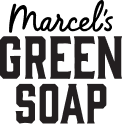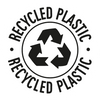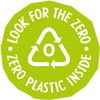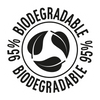Did you know that only 15% of plastics are reused in the Netherlands? The rest is burned or ends up in nature. And in the meantime, the production of new plastic continues at full speed. This really needs to be improved. We don't need new plastic anymore, there is enough plastic on our planet! That is why Marcel's Green Soap chooses bottles made of 100% recycled plastic, made from old plastic packaging. Curious what that process looks like? Check out the video below.
Video production by SUEZ, 2018
As you can see in the video, the 100% recycled plastic bottles are made from collected plastic from local households. The collected plastic goes through a whole process before it becomes a new bottle:
- The waste is sorted and separated into different streams.
- The separated plastic is reduced into pieces of 5 to 10 cm, also known as 'shred'.
- Grinding mills grind the shred even finer into flakes, which are then washed.
- The flakes are melted and filtered to remove contaminants, after which the melt is chopped into granules in a kind of meat grinder.
- And there is the result: a recycled raw material with comparable properties to new plastic, to be reused in the plastics chain. In our case, bottles for Marcel's Green Soap soaps.
Special, right? That is why it is so important that we all continue to separate and collect plastic. But also that we as consumers consciously choose products in recycled plastic packaging (when you have the choice). Or even better: plastic-free packaging. If we all deal with this a little more consciously, we can slow down the production of new plastic.
TOGETHER AGAINST NEW PLASTIC
We really don't need new plastic anymore. There is already more than enough plastic on the planet! This is also evident from two studies by an international team of scientists: “The growth of global plastic production is faster than what the world can collect in plastic waste. Reducing this flow of plastic waste could only succeed if the rapidly increasing production of newly manufactured plastic is slowed down.”
And that existing amount of plastic waste on our planet? This can be reduced using existing technologies. “This includes collecting and recycling plastic waste, redesigning products to eliminate the use of non-recyclable plastics, expanding refill options and in some cases replacing existing materials. But solutions such as recycling (currently only 12% of all plastic worldwide is reused) would need to be greatly expanded.”
THIS IS HOW YOU CAN HELP
As described above, there are a number of ways to contribute. The first is of course handing in your plastic waste. And preferably well separated. On most packaging you will find information about how to best recycle the packaging. But you can do more to help the recycling process of plastic waste:
- Do not put different packages together, that is difficult for sorting machines
- Only put small plastic packaging in the plastic bin. Old toys or a garden chair can be taken to the environmental square
- Use a transparent bag so that it is visible that it contains plastic (and possibly cans and beverage cartons).
In addition, as a consumer you can consciously choose 100% plastic-free packaging, 100% recycled packaging or 100% recyclable packaging when purchasing. The latter category may not be the greenest choice, but it is a step in the right direction. At least you can be sure that the plastic can be reused. There are also plastics that cannot even be melted down again. This packaging becomes bandage anyway - and that is bad for the environment. Therefore, try to make conscious choices when you buy something. Every little bit helps!
Sources: Gerecycledeflessen.nl, National Geographic, Plastic Soup Foundation.









